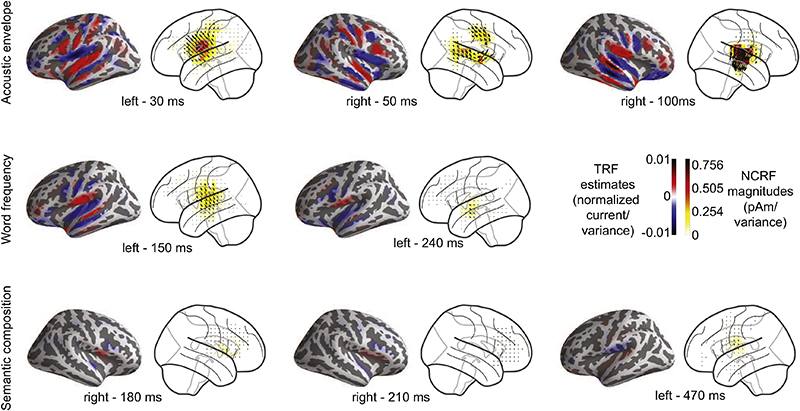 |

|
 |
Comparison of cortical spread of estimated NCRFs against MNE-boosting TRFs. (Fig. 8 from the paper)
|
|
The human brain routinely processes complex information as it unfolds over time. For example, when processing natural speech, information from lower levels has to be continuously processed to build higher level representations, from the acoustic signal to phonemes to words to sentence meaning. Quantitative characterization of the neural dynamics underlying such sensory processing is not only important in understanding brain function, but is also crucial in the design of neural prostheses and brain-machine interface technologies. It is a central problem in systems and cognitive neuroscience.
Thanks to their high temporal resolution, neuroimaging techniques such as magnetoencephalography (MEG) and Electroencephalography (EEG) have provided significant insights into the neural processing of continuous stimuli such as speech. Experimental evidence using these methods suggests that linear encoding models can be beneficial in predicting the key features of sensory processing.
Certain features of speech, such as the acoustic envelope, can be used as reliable linear predictors of the neural response manifested in M/EEG. The corresponding linear filters are referred to as temporal response functions (TRFs). While the functional roles of specific components of TRFs are well-studied and linked to behavioral attributes such as attention, the cortical origins of the underlying neural processes are not as well understood.
Neuro-current response functions: A unified approach to MEG source analysis under the continuous stimuli paradigm investigates this issue by estimating a linear filter representation of cortical sources directly from neuroimaging data in the context of continuous speech processing. This new paper by graduate student Proloy Das, ISR Postdoctoral Researcher Christian Brodbeck, Professor Jonathan Simon (ECE/Biology/ISR), and Assistant Professor Behtash Babadi (ECE/ISR) appears in the January 2020 issue of NeuroImage. Das is advised by Babadi.
The authors introduce Neuro-Current Response Functions (NCRFs), a set of linear filters, spatially distributed throughout the cortex, that predict the cortical currents giving rise to the observed ongoing MEG (or EEG) data in response to continuous speech. NCRF estimation is cast within a Bayesian framework, which allows unification of the TRF and source estimation problems, and also facilitates the incorporation of prior information on the structural properties of NCRFs. To generalize this analysis to M/EEG recordings which lack individual structural magnetic resonance (MR) scans, NCRFs are extended to free-orientation dipoles and a novel regularizing scheme is put forward to lessen reliance on fine-tuned coordinate co-registration.
The authors present a fast estimation algorithm, the Champ-Lasso algorithm, by leveraging recent advances in optimization. They demonstrate its utility through application to simulated and experimentally recorded MEG data under auditory experiments. Their simulation studies reveal significant improvements over existing methods that typically operate in a two-stage fashion, in terms of spatial resolution, response function reconstruction, and recovering dipole orientations. The Champ-Lasso algorithm infers the NCRFs (as spatiotemporal models of cortical processing) in a robust and scalable fashion.
Related Articles:
New algorithms for estimating the latent dynamics underlying biological processes
‘Priming’ helps the brain understand language even with poor-quality speech signals
The brain makes sense of math and language in different ways
NIH grant furthers poststroke recovery research of Marsh, Simon
Emerging from the fog: Little understood post-stroke cognitive issues verified
Simon, Lau to investigate neural bases of natural language understanding
Stop—hey, what’s that sound?
New UMD Division of Research video highlights work of Simon, Anderson
Autism Research Resonates in Hearing-Focused Project
Discovering a digital biomarker for post-stroke cognitive problems
February 17, 2020
|

